 ... the product of the two, plus the square of the second. In the third case, we have (a + b) (a — 6) = a2 — b2. (3) That is, the product of the sum and difference of two quantities is equal to the difference of their squares. ... the product of the two, plus the square of the second. In the third case, we have (a + b) (a — 6) = a2 — b2. (3) That is, the product of the sum and difference of two quantities is equal to the difference of their squares.  A Treatise on Algebra - Page 189by Elias Loomis - 1846 - 346 pagesFull view A Treatise on Algebra - Page 189by Elias Loomis - 1846 - 346 pagesFull view - About this book
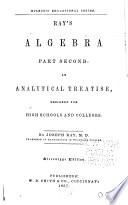 | Joseph Ray - Algebra - 1857 - 408 pages
...3)2=25— 30+9=4. 2. 3. (3x— 5z)2=9 4. (02— 3ca:)2=a2z2— Gacxz+QcW. ART. 8O. THEOREM III. — The product of the sum and difference of two quantities, is equal to the difference of their squares. Let a represent one of the quantities, and i the other ; then o-|-i=their sum, and a — i=their difference.... | |
 | William Smyth - Algebra - 1858 - 344 pages
...quantity, minus the double product of the first by the second, plus the second power of the second. 5. The product of the sum and difference of two quantities is equal to the difference of their second powers. The questions, art. 15, will furnish additional exercises for the learner in stating... | |
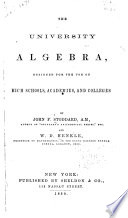 | John Fair Stoddard, William Downs Henkle - Algebra - 1859 - 538 pages
...11, Square 2z-<"-1)yJ^J'-5«*L-1y I • w+nt-3 ..."M-"12, Square^ = y r— 4« THEOREM III. (111.) The product of the sum and difference of two quantities is equal to the difference of their squares. DEMONSTRATION. Let a + b and a—b represent respectively the sum and difference of two quantities.... | |
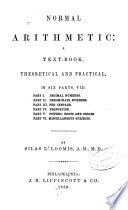 | Silas Lawrence Loomis - Arithmetic - 1859 - 324 pages
...1849. Or by Prin. 2 : 43 = 40 + 3. 432 = 1600 + 2x 120 + 9 = 1849. 358. PRIN. 4. — THE PRODUCT or THE SUM AND DIFFERENCE OF TWO QUANTITIES, IS EQUAL TO THE DIFFERENCE OF THEIR SQUARES. ILLUSTRATION. — 11+ 7 = 10. 11— 7 = _4 121 — 49 = 72. Ans. 3«59. PRIN. 5. — EVERY NUMBER MAY... | |
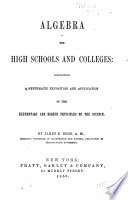 | James B. Dodd - Algebra - 1859 - 368 pages
...Thus (/3+v/2)x(/3— /2)=3 — 2=1. The product in this case is readily found on the principle, that the Product of the sum and difference of two quantities is equal to the dif ference of the squares of the two quantities. 3. A trinomial containing irrational square roots... | |
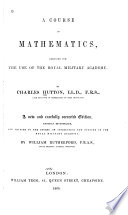 | Charles Hutton - Mathematics - 1860 - 1020 pages
...103. To find multipliers which will render binomial surds rational. produce a rational result; and since the product of the sum and difference of two...quantities is equal to the difference of their squares, we have, evidently, 'a = a; (-v/a — л/*) (Va+Vb) = a — b x1 = *; (x + Vy) (* - Vy] = *4-y y-^y! (V*... | |
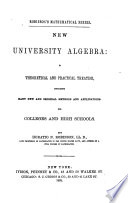 | Horatio Nelson Robinson - Algebra - 1863 - 432 pages
...the first and second, plus the square of the second. III. (ti+6) (a— Z»)=a'— b3 Or, in words, The product of the sum and difference of two quantities is equal to the difference of their squares. By the aid of these formulas we are enabled to write the square of any binomial, or the product of... | |
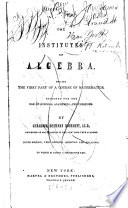 | Gerardus Beekman Docharty - Algebra - 1862 - 336 pages
...(f-î)'= If we multiply af 6 by a— ¿), we shall have From which we derive the following THEOREM III. The product of the sum and difference of two quantities is equal to the difference of the squares of those quantities. EXAMPLES. 1. (3xm+2y")(3xm-2if)=9x*"-4y'". Ans. 2. (ж+|)(ж-1)= Ans.... | |
 | Benjamin Greenleaf - 1863 - 338 pages
...62 — 10 a2 W ? Ans. 25 а4 64 — 100 a4 6s + 100 a4 6e. THEOREM III. Î8. The product of the sinn and difference of two quantities is equal to the difference of their squares. For, let a represent one of the quantities, and b the other ; then, (a + 6) X (a — 6) = a' — V,... | |
 | Olinthus Gregory - 1863 - 482 pages
...the expression becomes freed from the surds in the denominator, because the product of the sum oiid difference of two quantities is equal to the difference of their squares. Examples. r-: 8 = 8 v/5 + v/3 — 8 (v/5 + v/3) _ - v/5 — v/3 v/5 — v/3 -y/5 + v/3 ~ 3 4 (v/5 +... | |
| |